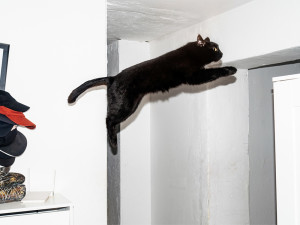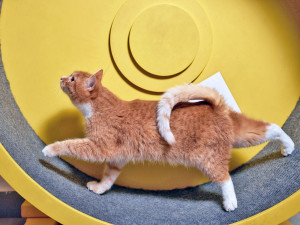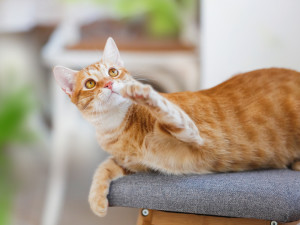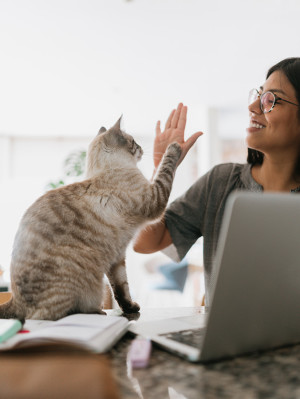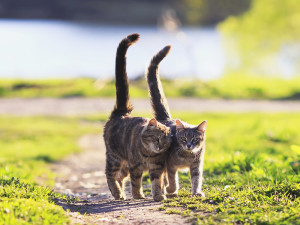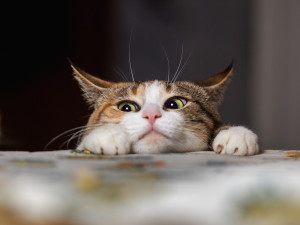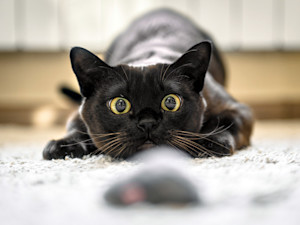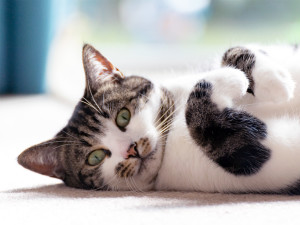Why Cats Are So Good At Obstacle Courses, According To Science
Walk this way...
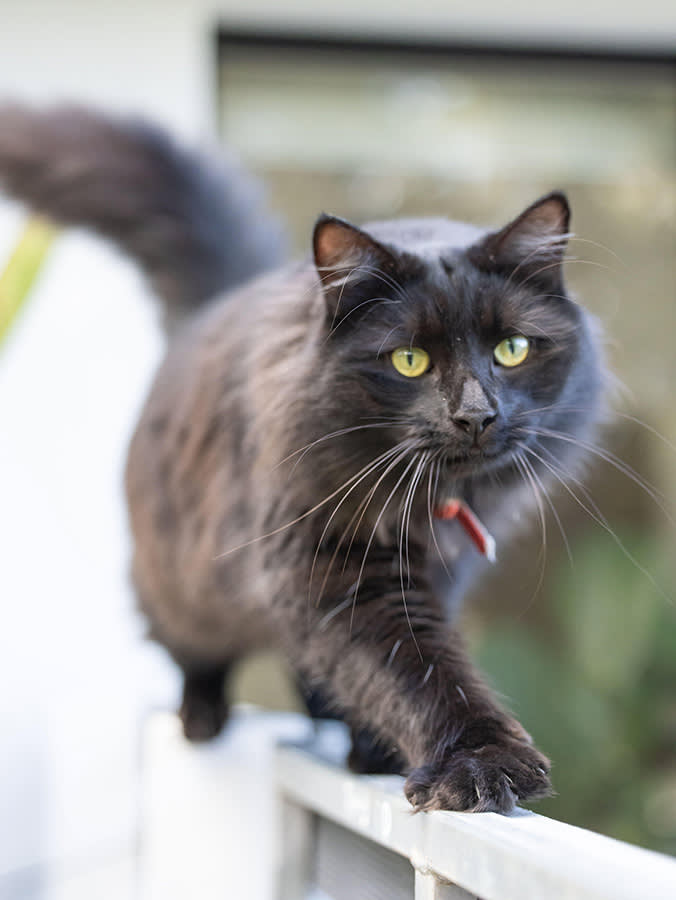
Share Article
If your social media algorithm has been showing you endless videos of cats expertly trotting through homemade obstacle coursesopens in new tab without knocking anything over, then you may have wondered what it is about a cat’s anatomy that makes them so adept at navigating tricky spaces or balancing on narrow ledges. We spoke to the experts to find out.
How do cats walk?
One of the theories around why cats on TikTok and Instagram so easily sail over a tower of plastic cupsopens in new tab without knocking a single one down is that there’s something special or unusual about their gait and the way they move.
The internet falls roughly into two camps on this point: one popular opinion is that cats walk first with both left legs at the same time, then both right, like camelsopens in new tab or giraffesopens in new tab. But very few animals walk like this and cats aren’t actually one of them. The other camp has the correct idea: rather than both limbs on each side hitting the ground at the same time, cats adopt a pattern known as a four-beat gaitopens in new tab, where each foot hits the ground independently.
It means that, as special as we often believe cats’ walking ability to be, they actually just walk like most other four-legged animals, says Dr Alison Wills, animal lecturer at Hartpury University.
“It’s not that exciting,” she laughs, somewhat apologetically. “Cats just do the same walk as other quadrupedal animals, like horses. It’s a very stable gait where you see the limbs on the same side contacting the ground one after the other: left hind then left fore.”
She can, however, see where some of the confusion has come from. Cats usually have three limbs in contact with the ground at any one time, making it hard to judge which leg is moving when. One of the other reasons for the confusion, she suggests, is that there are very few studies into what she calls ‘cat locomotion’.
Dogs and horses movement, however, have been extensively studied because – unlike cats – they’re often competition animals. Researchopens in new tab in to the way dogs walk found it is in fact dogs who occasionally walk like camels or giraffes – both left legs followed by both right legs, a gait known as ‘pacing’, which is a lateral two-beat gait.
“You tend to see it in larger dog breeds that have long legs which are close together, like Greyhounds, so we think it’s potentially to do with anatomy – they pace to avoid interference between their legs,” says Dr Wills.
“With domestic cats, they don’t tend to vary a lot in their shape and size, whereas with dogs, there is a lot more variation, from Chihuahuas to Great Danes. So that’s potentially why we see more gait variation in dogs.”
Research shows that there seems to be only one unusual situation in which a cat will ‘pace’. A studyopens in new tab (albeit a slightly dated one from 1993) found that a cat will pace if they’re… on a treadmill. Note: although there is a rising trend of ‘cat gyms’ online as well, you should never put your cat on a treadmill!
Posture and processing
That’s not to say there’s nothing at all about a cat’s anatomy that allows them to perform impressive feats. They’ve been blessed with a natural stance that helps them navigate their space more easily.
“Cats have what we call a crouched limb posture,” says Dr Wills. “If you look at dogs or horses they have quite a straight leg but cats have a more flexed leg, so their ability to negotiate obstacles and be accurate in their locomotion is potentially down to this limb posture.”
What this position does, Dr Wills explains, is bring their body mass closer to the ground. “That means they’re less likely to fall over when negotiating their environment, as cats are doing in some of these viral videos.”
Cats aren’t only relying on anatomical gifts though. They’re also using something called visuomotor integration: the act of processing the visual information and turning it into a movement. A study in 2022opens in new tab tasked cats with walking across a horizontal ladder in scenarios where vision was both clear and interrupted. It found that, just like humans, cats rely on their sight to move through complex terrain. Researchers found the test cats that were denied visual input prolonged their next movement and overall, concluded that the cats needed visual information for accurate stepping.
But there’s more to it than that, explains Dr Wills. “With cats, it’s not just how well they see their environment but how they process that information, and then use it to know where to place their leg accurately, so they’re not knocking over obstacles.”
Best paw forwards
This combination of skills might explain why some cats are better at navigating their spaces than others – there’s not just one factor at play but a combination of the individual cat’s cognitive and visual abilities.
However, it’s yet another area that’s lacking in research, which is perhaps why we continue to find cats and their quirks so perplexing. But there is one study that suggests a fun factopens in new tab: cats tend to have a favourite paw.
Researchers in 2020 tasked 41 cats with opening a lid in order to reach a food reward and found those that showed a clear preference for one paw were able to successfully open more lids. The results also suggested that cats who showed a paw preference in the task also tended to use that paw first in everyday life.
“You might have some cats that are ambilateral, which we’d call ambidextrous in people, but this study showed that the majority of cats do have a dominant paw and demonstrate laterality paw preference,” adds Dr Wills. “There doesn’t seem to be a preference across all cats, where more are right-handed as opposed to left, but if you look at the level of the individual cat, there does seem to be a preference.”
So while cats continue to be a mystery in many ways – including the exact mechanics of how they walk – you can be confident that your favourite feline is at least likely to be putting their best paw forwards. Teach them to give you a high five and perhaps you too will become an Instagram sensation.

Lauren Potts
Lauren is a freelance journalist who’s written for the BBC, Stylist, Refinery29, Who Do You Think You Are? magazine, the i newspaper and Time Out. She’s a family history nerd with a ferocious sweet tooth, a penchant for posh hotels, and a needy chunk of a cat called Nino that knows the word ‘chicken’.
Related articles
Dream of High-Fiving Your Cat? Here’s How to Teach a Cat Tricks
It takes some patience (shocker), but it can be done
![Two cats walking with their tails sticking straight up]()
Tail Talk: What Is Your Cat Trying to Tell You?
Cats are enigmas. But their tail movements can reveal a lot about their moods
![Cat grabbing onto ledge of table and looking to the left]()
Is Your New Cat Stalking You?
Yes, they are right behind you
![]()
How Cats Hunt
Cats have evolved to be skilled hunters, but how and why do they still do it?
![tri-colour, calico cat, white, black and tabby cat lying on their back with their paws lifted, looking at the camera]()
10 Common Cat Myths (That Are Actually False)
Peel back the layers of mystery to discover the truth about our feline friends

